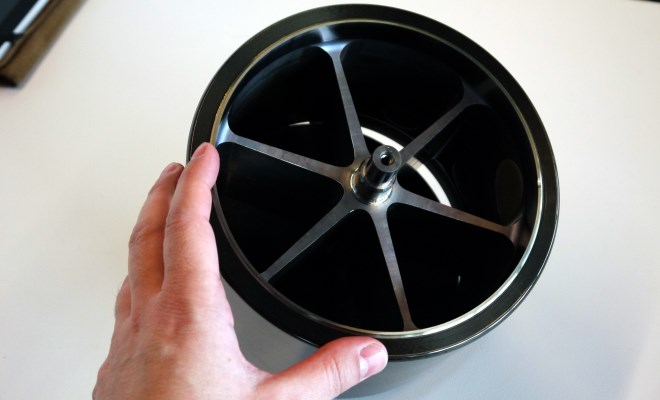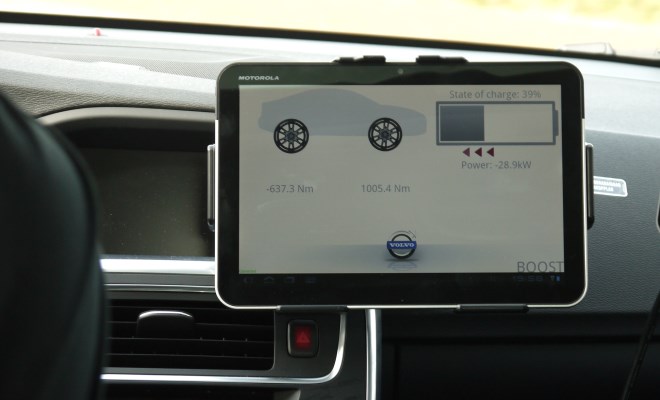by Lem Bingley 
Testing cars often seems to involve working at unreasonable hours. The time in Sweden may run an hour ahead of the UK, but my body still thinks it ought to be asleep as I blink through the pale morning light at a very ordinary-looking Volvo S60. Did I really get up for this?
But it’s not ordinary because even as it sits motionless on the tarmac it’s emitting a high-pitched whine like a spin dryer turned up to 11, or a helicopter girding itself for takeoff. This is not a noise my brain is ready to grasp just yet.
The striking sound is leaking out from under the bootlid, where Volvo has clamped a Formula 1 inspired KERS unit to the back axle of this particular plain black saloon. KERS stands for kinetic energy recovery system, which is a fancy name for regenerative braking. And while we’ve become used to regen that feeds power into a battery – in hybrids like the Prius or even in outwardly conventional cars like the BMW 320d – this particular system is different. It stores its recaptured momentum in purely mechanical form, in a fast-spinning flywheel.

And by fast I mean properly quick. When spinning at full tilt, the flywheel completes 1,000 full revolutions every second. The wheel is only about 20cm across, a 6kg drum of machined steel rimmed with a thick layer of carbon fibre. At 60,000rpm the outside edge of the carbon ring nudges Mach 2 and is being flung outward with a force 200,000 times as strong as gravity. If it were a spin dryer, wet socks would emerge very dry indeed, assuming they weren’t pulverised into dust.
I wouldn’t like to think how far the spinning flywheel might travel if dropped loose onto the road, but it is very safely contained inside a strong housing, designed to withstand F1-speed impacts. Apparently the wheel itself will hold together at up to twice its rated spin.
Almost all traces of atmosphere have been pumped out of the flywheel chamber, helping to reduce energy losses through friction and heat. Left to spin idly at full pelt, it will take around half an hour to run down to a stop, I’m told.

The flywheel’s job is not to hang onto momentum for that long, however. It is designed to capture kinetic energy as the S60 slows, and release it again a short while later when the car needs to speed up again. It does exactly the same job as the battery and motor in an electric hybrid, and is linked through to the Volvo’s rear wheels via a continuously variable transmission (CVT), clutch and differential.
Incidentally, while the prototype may be Swedish, and cost 20 million kroner to build (about £2m), the KERS kit itself is British, made by Silverstone-based Flybrid Automotive with a CVT built by Torotrak in Lancashire.
Capture and release of the flywheel’s energy is computer controlled, and Volvo has created two different driver-selectable modes: Hybrid, which improves fuel economy; and Sport, which provides an extra boost for acceleration. Both are accessed via software running in a tablet computer, docked next to the steering wheel, which also provides a simple graphical display of energy flows.

At its peak the flywheel can store 150Wh, which is not actually a great deal of energy by battery-hybrid standards. Even the puny Honda Jazz Hybrid can stuff four times as many Watt-hours into its nickel-metal-hydride battery. But Volvo’s KERS system can fill and empty its store very quickly and efficiently, giving it better odds for improving performance than you might suspect. On full boost, it can add 60kW (80bhp) to the party, or about six times as much power as the motor in the Jazz.
My envelope arithmetic suggests that if you spend 150Wh at a 60kW rate it will be used up in just nine seconds. With frictional losses, as Volvo’s engineers concede, we are talking about six or seven seconds of full boost.
That is quite long enough to make a big difference, however. Under the bonnet of the S60 prototype sits a 2.5-litre five-cylinder petrol engine, sending 254bhp through a six-speed automatic gearbox to the front wheels. Standstill to 62mph usually takes a relatively brief seven seconds. With KERS adding the equivalent of another litre or so of grunt at the back axle, the sprint is cut down to under 5.5 seconds.

Equally, KERS could kick in with its extra 80 horses at more important times, like when trying to zip past a plodding tractor on a Norfolk road. The boost it provides is unmistakeable, in Sport mode at least. Volvo has set up the KERS unit to send power to the rear wheels from 25mph, if the throttle is appropriately pressed. Hit that speed and the energy is flushed urgently out of the flywheel to help you go faster – you can hear the note of the flywheel dropping down through the octaves even as the horizon rushes ever faster towards you. I’m told a production version would be a lot quieter, and that would almost be a shame. It’s visceral to be able to hear the KERS module working even as it pushes you firmly back into your seat.
As soon as you come off the throttle, brake, or simply hold a constant speed, the KERS note will rise back up once more, as the flywheel progressively borrows energy from the rear axle so that it can be geared up and ready to help again when you next stab the accelerator with urgency.
That’s Sport mode. In Hybrid mode, the KERS module no longer strives to keep itself ready for action but instead remains on standby for fuel saving. Brake or slow down, and the KERS note will rise as energy is squirreled away in the flywheel. Speed up again, even gently, and the note will fall right down to silence as the KERS energy is released to help you on your way. If it didn’t make a noise, you’d never guess it was there.

In this economy cycle, combined power is capped at the engine’s 254bhp, and the computers subtract any KERS contribution from the petrol power. As a result you can’t feel any difference in throttle response as you climb an incline, for example, with KERS helping at the bottom but spun out of energy before you reach the top, the engine smoothly increasing its share of the work.
Despite only operating for a few seconds at a time, KERS can still make a big difference in fuel economy, easing consumption and trimming CO2 emissions by 25% in the standard NEDC test, despite a relatively modest 60kg increase in weight.
On real roads, KERS fuel savings will be most apparent wherever slowing down and speeding up occurs frequently – in traffic jams, on urban routes and on twisting B-roads, for example.
Climbing out of today’s gently humming prototype, it’s clear that KERS holds great promise for road cars, as a potentially simpler and cheaper kind of hybrid than the sort we’ve become used to over the past decade. Volvo has already done a lot of the homework necessary to ensure the system would be safe to use – its V60 Plug-in Hybrid production car uses a similarly powerful electric rear-axle, and the KERS prototype was able to borrow stability software and other bits and pieces from that car.
According to the engineers I spoke to, the prototype has provided enough data for the business to start making decisions about whether KERS has a future in Volvo road cars. Whether we will ever see flywheel KERS in a showroom now depends on the mundane business of working out costs and benefits. That, plus the unusual task of finding a supplier able to make high-precision, carbon-fibre flywheels fit for a production line rather than a prototype.
Driving Volvo’s road-car KERS prototype
28 May 2013
Read more about: fuel economy hybrids Volvo



